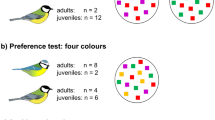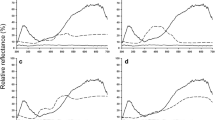Abstract
Few studies have dealt with the importance of colours per se in warning signalling, with the use of a broader array of different colours. We tested the reactions of great tits (Parus major) to colour modifications (red, orange, yellow, white, blue, violet, and green) of the warning signal of the red firebug (Pyrrhocoris apterus), preserving its typical black pattern. We used the edible Guyana spotted roach (Blaptica dubia) as the prey, each of which carried a paper sticker shield of a particular colour on its back. With such prey, the effects of the other traits of the red firebug (e.g. shape of the legs and antennae or chemical signals) on the birds’ reactions were removed. All of the conspicuous forms of the prey, possessing a black pattern, were protected against great tits better than the non-patterned brown control form. The level of protection decreased from those forms with colours similar to the model and commonly occurring in warning signals in nature (red, orange, yellow), through other conspicuous colours rarely occurring in warning signals in nature (white, violet, blue), to the colour which usually occurs as cryptic in nature (green). In the green form, repeated encounters were necessary to reach avoidance. Avoidance learning came to pass despite the fact that the presented prey was neither inedible nor distasteful.




Similar content being viewed by others
References
Aronsson M, Gamberale-Stille G (2009) Importance of internal pattern contrast and contrast against the background in aposematic signals. Behav Ecol 20:1356–1362
Bonacci T, Aloise G, Brandmayr P, Brandmayr TZ, Capula M (2008) Testing the predatory behaviour of Podarcis sicula (Reptilia: Lacertidae) towards aposematic and non-aposematic preys. Amphib-Reptil 29:449–453
Cardoso MZ (1997) Testing chemical defence based on pyrrolizidine alkaloids. Anim Behav 54:985–991
Collins CT, Watson A (1983) Field observations of bird predation on neotropical moths. Biotropica 15:53–60
Cott HB (1940) Adaptive coloration in animals. Methuen, London
Edmunds M (1974) Defence in animals. A survey in antipredator defences. Longman, Essex
Exnerová A, Svádová K, Štys P, Barcalová S, Landová E, Prokopová M, Fuchs R, Socha R (2006) Importance of colour in the reaction of passerine predators to aposematic prey: experiments with mutants of Pyrrhocoris apterus (Heteroptera). Biol J Linn Soc 88:143–153
Fisher RA (1930) The genetical theory of natural selection. Mimicry, 1st edn. Dover, New York
Forsman A, Herrström J (2004) Asymmetry in size, shape, and color impairs the protective value of conspicuous color patterns. Behav Ecol 15:141–147
Gamberale-Stille G (2000) Decision time and prey gregariousness influence attack probability in naive and experienced predators. Anim Behav 60:95–99
Gamberale-Stille G, Sillén-Tullberg BS (1999) Experienced chicks show biased avoidance of stronger signals: an experiment with natural colour variation in live aposematic prey. Evolut Ecol 13:579–589
Ham AD, Ihalainen E, Lindström L, Mappes J (2006) Does colour matter? The importance of colour in avoidance learning, memorability and generalisation. Behav Ecol Sociobiol 60:482–491
Hart NS, Partridge JC, Cuthill IC, Bennett ATD (2000) Visual pigments, oil droplets, ocular media and cone photoreceptor distribution in two species of passerine bird: the blue tit (Parus caeruleus) and the blackbird (Turdus merula). J Comp Physiol A 186:375–387
Ihalainen E, Lindstrom L, Mappes J, Puolakkainen S (2008) Butterfly effects in mimicry? Combining signal and taste can twist the relationship of Mullerian co-mimics. Behav Ecol Sociobiol 62:1267–1276
Ingalls V (1993) Startle and habituation responses of blue jays (Cyanocitta cristata) in a laboratory simulation of antipredator defenses of Catocala moths (Lepidoptera, Noctuidae). Behaviour 126:77–96
Kikuchi DW, Pfennig DW (2010) Predator cognition permits imperfect coral snake mimicry. Am Nat 176:830–834
Marples NM, Kelly DJ (1999) Neophobia and dietary conservatism: two distinct processes? Evolut Ecol 13:641–653
Poulton EB (1890) The colours of animals: their meaning and use, especially considered in the case of insect. Kegan Paul, London
Prokopová M, Veselý P, Fuchs R, Zrzavý J (2010) The role of size and colour pattern in protection of developmental stages of the red firebug (Pyrrhocoris apterus) against avian predators. Biol J Linn Soc 100:890–898
R development core team (2013) R: a language and environment for statistical computing. R Foundation for Statistical Computing, Vienna, Austria
Ritland DB (1998) Mimicry-related predation on two viceroy butterfly (Limenitis archippus) phenotypes. Am Midl Nat 140:1–20
Rowe C, Guilford T (1999) The evolution of multimodal warning displays. Evolut Ecol 13:655–671
Rowe C, Skelhorn J (2005) Colour biases are a question of taste. Anim Behav 69:587–594
Rowland HM, Mappes J, Ruxton GD, Speed MP (2010) Mimicry between unequally defended prey can be parasitic: evidence for quasi-Batesian mimicry. Ecol Lett 13:1494–1502
Schuler W, Hesse E (1985) On the function of warning coloration: a black and yellow pattern inhibits prey-attack by naive domestic chicks. Behav Ecol Sociobiol 16:249–255
Siddiqi A, Cronin TW, Loew ER, Vorobyev M, Summers K (2004) Interspecific and intraspecific views of color signals in the strawberry poison frog Dendrobates pumillo. J Exp Biol 207:2471–2485
Sillén-Tullberg BC, Wiklund CH, Järvi T (1982) Aposematic coloration in adults and larvae of Lygaeus equestris and its bearing on Müllerian mimicry: an experimental study on predation on living bugs by the great tit Parus major. Oikos 39:131–136
Stevens M, Stubbins CL, Hardman CJ (2008) The anti-predator function of “eyespots” on camouflaged and conspicuous prey. Behav Ecol Sociobiol 62:1787–1793
Tullberg BS, Merilaita S, Wiklund C (2005) Aposematism and crypsis combined as a result of distance dependence: functional versatility of the colour pattern in the swallowtail butterfly larva. Proc R Soc Lond B 272:1315–1321
Veselý P, Fuchs R (2009) Newly emerged Batesian mimicry protects only unfamiliar prey. Evolut Ecol 23:919–929
Veselý P, Luhanová D, Prášková M, Fuchs R (2013a) Generalization of mimics imperfect in colour patterns: the point of view of wild avian predators. Ethology 119:138–145
Veselý P, Veselá S, Fuchs R (2013b) The responses of Central European avian predators to an allopatric aposematic true bug. Ethol Ecol Evol 25:275–288
Vorobyev M, Osorio D (1998) Receptor noise as a determinant of colour thresholds. Proc R Soc Lond Ser B 265:351–358
Vorobyev M, Osorio D, Bennett ATD, Marshall NJ, Cuthill C (1998) Tetrachromacy, oil droplets and bird plumage colours. J Comp Physiol A 183:621–633
Zrzavý J (1995) Morphological organization of abdominal color patterns in Pyrrhocorid bugs (Hemiptera-Heteroptera: Pentatomomorpha). J Zool Syst Evolut Res 33:3–8
Acknowledgments
We thank Christopher Mark Steer and Peter Lemkin for the language improvement. We thank the Grant agency of the University of South Bohemia (159/2013/P) for financial support. Experiments carried out in this research comply with the current laws of the Czech Republic. Authors are licensed for catching and ringing birds (Bird Ringing Centre Prague No. 1004 and 1159), for animal experimentation (Czech Animal Welfare Commission No. 489/01) and for conducting laboratory experiments with titmice (Ministry of Education, Youth and Sports, Licence No. 8809/2011-30). Faculty of Science of the University of South Bohemia has accredited breeding of titmice (Ministry of Agriculture, Licence No. 9103/2009-17210).
Author information
Authors and Affiliations
Corresponding author
Rights and permissions
About this article
Cite this article
Cibulková, A., Veselý, P. & Fuchs, R. Importance of conspicuous colours in warning signals: the great tit’s (Parus major) point of view. Evol Ecol 28, 427–439 (2014). https://doi.org/10.1007/s10682-014-9690-2
Received:
Accepted:
Published:
Issue Date:
DOI: https://doi.org/10.1007/s10682-014-9690-2




